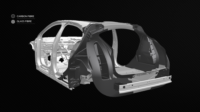COLOGNE, Germany—Engineers at Lanxess AG and Kautex Textron GmbH & Co. are developing plastic housings for high-voltage EV batteries. The goal of the R&D effort is to find a lightweight substitute for aluminum and steel that is cost effective, functional and electrically insulated.
Today, battery enclosures are primarily made out of extruded steel or aluminum profiles. Depending on the vehicle class, housings can be more than 6-feet long and 5-feet wide.
“The size, number of components and numerous manufacturing and assembly steps make metal housings very cost-intensive,” says Christopher Hoefs, Ph.D., e-power train project manager at Lanxess. “For example, complex structures made from strand press profiles require many secondary work steps, such as welding, punching and riveting. In addition, the metallic components must be protected against corrosion in an additional process step by cathodic dip coating.
“Plastics, on the other hand, can fully exploit their design freedom,” claims Hoefs. “By integrating functions, such as fasteners and thermal management components, the number of individual components of a battery housing can be greatly reduced. This simplifies assembly and logistical effort, which reduces production costs.
“Plastics are also corrosion-resistant and electrically insulating,” explains Hoefs. “The latter ensures that there is a reduced risk of the system short-circuiting. The low density of plastics and their potential for lightweight construction lead to significantly lighter housings, which benefits the range of electric vehicles.”
Battery housings must meet a variety of highly demanding technical requirements. For example, they must be stiff and strong, yet be able to absorb a significant amount of energy in the event of a crash. Enclosures must also be flame-retardant in the event of a vehicle fire or thermal run-away of the electrical cells. In addition, battery housings must be integrated into the vehicle structure.
The prototype plastic enclosure is based on the battery housing of a C-segment electric vehicle. It consists of a tray with crash structure, a cover and an underrun (underbody) protection. The housing’s components can be produced in a single-stage direct long fiber thermoplastic molding process.
“As a first step, we have completely dispensed with the use of metallic reinforcement structures while proving we can commercially produce these complex large components,” says Felix Haas, director of product development at Kautex Textron. “Going forward, [we] want to enter into development projects for series production with automotive manufacturers.”



